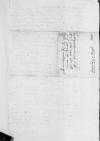Vestrae Reverendissimae Dominationis ⌊⌋ ex ⌊Gandavo⌋ de 1531-06-15⌊15 Iunii1531-06-15⌋ accepi ⌊Cracoviae⌋ 1531-07-05⌊5 Iulii[1] praeteriti1531-07-05⌋. Ubi fasciculum adiunctum meis[2] illico consignavi in manus domini ⌊Nicolai Nypschitz⌋, qui iam iam redierat ex curia ⌊regis mei⌋. Atque ⌊serenissima regina⌋ in continenti Vestrae Reverendissimae Dominationis litteras ad suam maiestatem datas[3] ad me ... illegible⌈...... illegible⌉ misit dans facultatem legendi primum quasi articulum, ubi ⌊⌋[4], ut ea ⌊serenissimo regi meo⌋ referrem[5]. Veni in curiam s⌊erenissimi regis mei⌋ et illic cum domino ⌊Hieronimo Laski⌋[6] mansi per octo dies[7]. ⌊Ducem Atrii⌋[8] non vidi, cui ad mandatum Vestrae Reverendissimae Dominationis et omnibus percupide me adaptarem. Dominum autem ⌊Hieronimum Laski⌋ adduxi ex ⌊Cracovia⌋. Qui a quam pluribus terrebatur se, ne se fidei regis mei commiteret, utique ipse me audivit et mihi confidit. Venit quidem et clementer susceptus, tractatus, habitus et remuneratus dimissus[9]. Quem usque ⌊Viennam⌋ et in ipsam navim comitatus sum[10]. Satis contentum se testabatur de rege meo. ⌊Serenissimus item rex meus⌋ laudat hominis dexteritatem et consilium. Deus faxit, ut aliquid boni exinde sequatur. Venturum se pollicebatur cum collegis oratoribus[11] domini sui[12] ad ⌊caesaream maiestatem⌋. Respondissem iam antea Vestrae Reverendissimae Dominationi, attamen non tantum otii dabatur, iam negotiando, iam potando et consumando distractus.
⌊Serenissima regina Poloniae⌋ narravit mihi Vestram Reverendissimam Dominationem cupere ab hoc onere legationis absolvi[13] at inquit se Vestrae Reverendissimae Dominationi respondisse neminem esse, qui tam cito posset informari de his suae maiestatis negotiis[14]. Necesse esse Vestram Reverendissimam Dominationem ea in finem deducere. Sua ⌊reginalis maiestas⌋ se omnino ⌊serenissimo rege meo⌋ adiunxit et video iam ferme omnem ⌊Poloniam⌋ mutatam[15] quoad voluntatem erga ⌊serenissimum regem meum⌋, qui promisit se promoturum negotia illa[16] apud ⌊caesaream maiestatem⌋ summa diligentia. Vestra Reverendissima Dominatio promoveat etiam, ut amor inter nostros principes crescat et firmetur, unde omnibus nobis salus. His Vestrae Reverendissimae Dominationi, quam Deus felicem conservet, me et servitia mea commendo.


 UUB, H. 154, f. 71v
UUB, H. 154, f. 71v